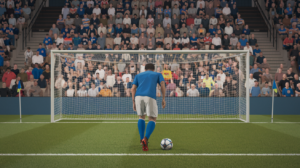In soccer, the throw-in is a fundamental part of the game that occurs when the ball goes out of play over the touchline.
Understanding the soccer throw-in rules and FIFA Law 15 is crucial for players and coaches alike, as it ensures that throw-ins are executed correctly and can significantly impact the flow of the match.
This article will provide a comprehensive overview of how to perform a throw-in, covering essential techniques, common mistakes, and strategies for both youth and adult soccer.
- What is a Throw-In?: A throw-in is awarded when the ball crosses the touchline and is restarted by the opposing team.
- Importance of Correct Execution: Proper technique and adherence to the rules are vital for maintaining fair play and strategic advantage.
- Goals of the Article: You will learn about the throw-in procedure, common errors to avoid, and tips for maximizing the effectiveness of throw-ins.
Whether you’re a player aiming to refine your technique or a coach looking to improve your team’s performance, this guide will help you master the throw-in and understand its impact on the game.
What is a Soccer Throw-In?
A soccer throw-in occurs when the ball crosses the touchline, and the game is restarted by the team that did not touch the ball last.
It is a crucial aspect of the game, providing a way to reintroduce the ball into play and potentially create scoring opportunities or regain possession.
Understanding the basics of a throw-in helps players and coaches navigate this common event with greater confidence and efficiency.
- Definition and Purpose: A throw-in is awarded when the ball goes out of play over the touchline, either by being kicked or carried out. The team that did not touch the ball last gets possession and restarts the game from the point where the ball went out.
- Position on the Field: Throw-ins usually occur along the touchlines of the field, and the exact location where the throw-in is taken is determined by where the ball crossed the line. Proper positioning is essential for executing an effective throw-in and gaining advantage.
- Role in the Game: Throw-ins can influence the flow of the game significantly. A well-executed throw-in can lead to quick offensive plays or defensive positioning, while a poorly executed one can give the opposing team an opportunity to regain possession.
By mastering the throw-in, players can enhance their ability to contribute to their team’s strategy, whether it’s for maintaining possession, advancing the ball, or setting up a play.
Proper understanding and execution of throw-ins are integral to both individual performance and team success.
Laws of the Throw-In

Understanding the laws governing throw-ins is essential for maintaining the flow and fairness of the game. According to FIFA Law 15, specific rules must be followed to ensure that throw-ins are performed correctly.
Here’s a detailed look at these regulations and common misconceptions surrounding them.
- Law 15 – The Throw-In: FIFA Law 15 outlines the rules for executing throw-ins. It specifies that the thrower must face the field of play, have part of each foot on or behind the touchline, and use both hands to deliver the ball from behind their head. Failure to adhere to these requirements can result in the throw-in being awarded to the opposing team.
- Correct Procedure:
- Body Positioning: The thrower must stand with their feet on or behind the touchline, ensuring that the ball is thrown from behind the head and both hands are used. This positioning is crucial for a legal throw-in.
- Throwing Technique: The ball must be thrown with both hands, and the thrower’s feet must remain on or behind the touchline. A legal throw-in should be performed with a continuous motion and must not involve any spinning or twisting of the body.
- Infringements and Misconceptions:
- Illegal Throw-Ins: Common mistakes include lifting both feet off the ground, using only one hand, or stepping over the touchline before the ball is released. Such errors result in a throw-in awarded to the opposing team.
- Common Myths: One prevalent misconception is that the ball can be thrown with a flick of the wrist. In reality, the throw must be executed from behind and over the head with both hands.
By adhering to these laws, players can avoid common mistakes and ensure that their throw-ins are executed properly, thereby minimizing errors and enhancing their team’s performance.
How to Perform a Legal Throw-In
Executing a throw-in correctly is crucial for maintaining possession and adhering to the game’s rules.
Mastering the soccer throw-in technique involves understanding the proper stance, grip, and motion to ensure the throw is legal and effective.
Here’s a step-by-step guide to performing a legal throw-in:
- Step-by-Step Guide:
- Initial Position: The thrower should start by positioning themselves with their feet on or behind the touchline. Both feet must remain on or behind the line throughout the throw.
- Handling the Ball: Hold the ball with both hands and position it behind your head. The ball must be carried from behind the head, not flicked or tossed from the front.
- Throwing Motion: Use a continuous motion to throw the ball over your head. Both hands should be used to propel the ball forward. Ensure that your feet remain on or behind the touchline and that you do not step onto the field or across the line before releasing the ball.
- Visual Aids:
- Diagrams: Illustrated diagrams can show the correct body position, hand placement, and throwing motion. For example, a diagram should highlight the feet-on-the-line position and the ball being thrown from behind the head.
- Video Links: Watching instructional videos can provide a clearer understanding of the throw-in technique. Recommended videos often include demonstrations of the proper technique and common errors to avoid.
Practicing the correct technique is essential for mastering the throw-in.
Regular drills and video analysis can help players refine their skills and ensure they are compliant with the rules.
By focusing on these elements, players can execute throw-ins more effectively and contribute positively to their team’s performance.
Strategic Use of Throw-Ins

Throw-ins are more than just a way to restart the game; they can be a powerful tool for tactical advantage when used strategically.
Understanding throw-in strategies can significantly impact a team’s performance by creating opportunities or applying pressure. Here’s how to make the most out of throw-ins:
- Basic Strategies:
- Short Throw-Ins: These are used to quickly pass the ball to a nearby teammate, maintaining possession and facilitating quick play. Short throw-ins are ideal for maintaining control and disrupting the opponent’s defensive organization. The thrower should aim to deliver the ball to a player who is in a better position to advance the play or make a pass.
- Long Throw-Ins: When executed correctly, long throw-ins can reach the opponent’s penalty area, potentially leading to goal-scoring opportunities. This type of throw-in requires more power and technique to ensure the ball travels the necessary distance. It’s often used to launch attacks or put pressure on the opponent’s defense.
- Advanced Techniques:
- Quick Throw-Ins: This involves taking a throw-in quickly before the opposing team has a chance to organize their defense. Quick throw-ins can catch opponents off-guard and create immediate attacking opportunities. To execute this effectively, the thrower needs to be aware of their surroundings and have a pre-planned target.
- Combination Plays: Incorporating throw-ins into combination plays can enhance their effectiveness. For example, a throw-in can be combined with a short pass or a run to create space and open up new angles for attack. Teams can practice these combinations during training to develop fluid and unpredictable throw-in tactics.
By employing these strategies, players can leverage throw-ins to their advantage, turning a routine restart into a potential game-changing moment.
Effective use of throw-ins not only improves a team’s strategic options but also increases their chances of gaining an upper hand in key moments of the game.
Conclusion
Mastering the soccer throw-in is essential for players and coaches aiming to enhance their game performance and adhere to the rules of play.
A well-executed throw-in can significantly influence the flow of a match, providing opportunities to advance the ball or disrupt the opponent’s strategy.
By understanding the throw-in rules and employing effective techniques and strategies, players can leverage this aspect of the game to their advantage.
- Recap of Key Points: We’ve covered the fundamental aspects of throw-ins, including the legal procedures, common mistakes to avoid, and strategies for maximizing their impact. Understanding and practicing these elements ensures that throw-ins are executed correctly and used strategically.
- Final Tips: Regular practice and adherence to the laws will enhance throw-in effectiveness, allowing players to contribute more effectively during matches. Incorporate throw-ins into training drills to build confidence and precision.
- Call to Action: Explore further resources, such as instructional videos and coaching guides, to deepen your understanding and refine your technique. Engaging with these resources will support ongoing improvement and success on the field.
With this knowledge, players and coaches can approach throw-ins with greater confidence and skill, ultimately contributing to their team’s overall performance and success.

Justin Taylor is a fervent soccer enthusiast renowned for his ability to weave captivating stories around the sport. His talent lies in transforming detailed match analyses and player profiles into engaging narratives that resonate with readers on soccerworld.com.









